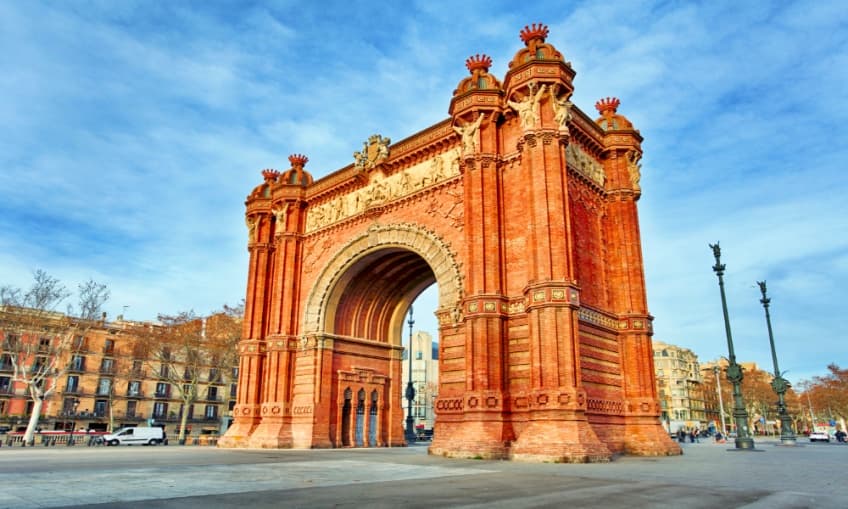
Arch of Triumph (Barcelona)
Located between Paseo de Lluís Companies, Ronda de San Pedro and Paseo de San Juan is the Arch of Triumph, which, unlike other European triumphal arches, was designed not to glorify military achievements, but, rather, to exalt scientific progress.
Designed by the famous architect José Vilaseca, the Arch of Triumph was conceived to be the entrance to the Universal Exhibition of Barcelona that took place in 1888. It was completely restored a century later.
Of clear neo-Mudéjar inspiration, it stands an impressive 30 meters high and is densely decorated with symbolic sculptures by Josep Llimona, Josep Reynés, Antoni Vilanova, Manuel Fuxá, Torquat Tasso, Magí Fita and Pere Carbonell.
Among the many allegories that can be seen in the Arch of Triumph is the Adhesion of the Nations to the Universal Contest made by Josep Reynés, in the upper frieze. In addition, there are the Reward, by Josep Llimona, located on the upper back; the allegories of Industry, Commerce and Agriculture on the right side, which are the work of Antoni Vilanova; and, on the left, the Arts and Sciences by Torquat Tasso. In addition, there are 12 female sculptures by Pere Carbonell and Manuel Fuxá, as well as the majolicas that decorate the entire arch, the work of Magí Fita.
It is a work of such powerful symbolism and attractive monumentality that it has been used as a finish line in the Barcelona Marathon and as a venue for important musical events such as Primavera Sound. In addition, it has been declared a Cultural Asset of Local Interest.
Designed by the famous architect José Vilaseca, the Arch of Triumph was conceived to be the entrance to the Universal Exhibition of Barcelona that took place in 1888. It was completely restored a century later.
Of clear neo-Mudéjar inspiration, it stands an impressive 30 meters high and is densely decorated with symbolic sculptures by Josep Llimona, Josep Reynés, Antoni Vilanova, Manuel Fuxá, Torquat Tasso, Magí Fita and Pere Carbonell.
Among the many allegories that can be seen in the Arch of Triumph is the Adhesion of the Nations to the Universal Contest made by Josep Reynés, in the upper frieze. In addition, there are the Reward, by Josep Llimona, located on the upper back; the allegories of Industry, Commerce and Agriculture on the right side, which are the work of Antoni Vilanova; and, on the left, the Arts and Sciences by Torquat Tasso. In addition, there are 12 female sculptures by Pere Carbonell and Manuel Fuxá, as well as the majolicas that decorate the entire arch, the work of Magí Fita.
It is a work of such powerful symbolism and attractive monumentality that it has been used as a finish line in the Barcelona Marathon and as a venue for important musical events such as Primavera Sound. In addition, it has been declared a Cultural Asset of Local Interest.
Location
Civil Buildings in Barcelona
Religious Buildings in Barcelona
Museums in Barcelona









